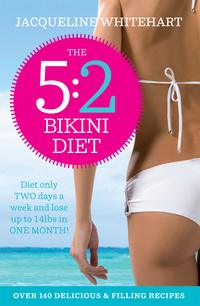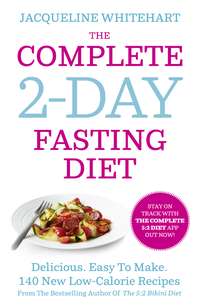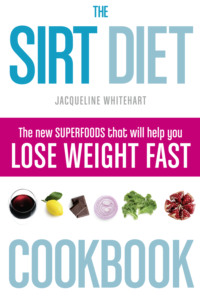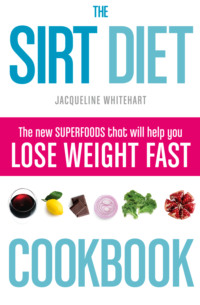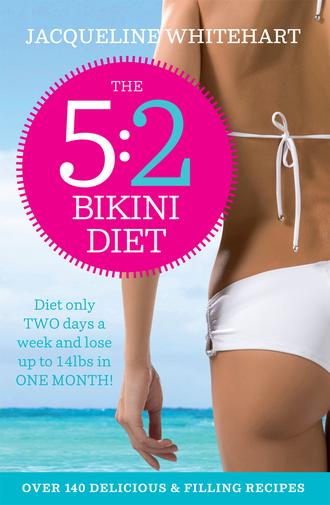
Полная версия
The 5:2 Bikini Diet: Over 140 Delicious Recipes That Will Help You Lose Weight, Fast! Includes Weekly Exercise Plan and Calorie Counter
Want to find out more about the health benefits?
Here are the studies referenced in this section. Be warned, most of it is not light reading, but it’s a very exciting field and could be worth the effort. Finally, this list is not exhaustive. This is because research in this field is booming and there are new studies coming out all the time. Look out for breaking news stories, which I believe will show more proof and more reasons to fast.
1 Parrella E., et al. ‘Protein restriction cycles reduce IGF-1 and phosphorylated Tau, and improve behavioral performance in an Alzheimer’s disease mouse model’,
http://www.scribd.com/doc/126262180/Longo-Cohen-Paper.
2 Mattson M., et al. ‘When a little poison is good for you’, New Scientist, 6 August 2008,
http://www.newscientist.com/article/mg19926681.700-when-a-little-poison-is-good-for-you.html.
3 Varady K., et al. ‘Alternate day fasting (ADF) with a high-fat diet produces similar weight loss and cardio-protection as ADF with a low-fat diet Metabolism’, pp137–143, January 2013.
4 Alken J., et al. ‘Effect of fasting on young adults who have symptoms of hypoglycaemia in the absence of frequent meals’, European Journal of Clinical Nutrition 2008; 62: 721–726.

How to customize the 5:2 diet for you
Everybody is different: different weight, different height and different fitness. In this chapter we work out your Body Mass Index (BMI) and metabolic rate (BMR), which is how many calories you burn in a day. By calculating your BMI, we can set suitable and sustainable weight-loss targets. By working out your personal metabolic rate we can set a personalized calorie intake guide for the fast days, and, as we know, every calorie counts on a fast day.
Recently, there have been improvements to the way the BMI is calculated. This is because the old scale of BMI didn’t work very well if you were tall or short or more muscular than average; Brad Pitt, for example, at the time of Fight Club was very muscular and would have been considered overweight using the old BMI, so the new scale aims to be more accurate for everyone.
It doesn’t make much difference if you are relatively average, but if you are short it can make your BMI higher and if you are tall it can reduce your BMI a little. If you are tall, like me, it’s worth having a look at the new calculator – I dropped by 0.5 points from 21.6 to 21.1. But if you are average height it won’t make a difference.
The simplest way to calculate your BMI is to use an online calculator, such as:
http://people.maths.ox.ac.uk/trefethen/bmi_calc.html
• A BMI of less than 18.5 is considered underweight.
• A BMI of 18.5 to 24.9 is considered a normal healthy weight.
• A BMI of 25 to 29.9 is considered overweight.
• A BMI of 30 or greater is considered obese.
Personalized calorie allowance on fast days
While we use the standard numbers of 500 calories as a quarter of a woman’s normal daily calorie intake and 600 calories as a quarter of a man’s, we can in fact be far more accurate.
By calculating your Metabolic Rate (MR) you can work out your daily calorie needs. The BMR is how many calories your body burns when at rest.
First calculate your BMR:
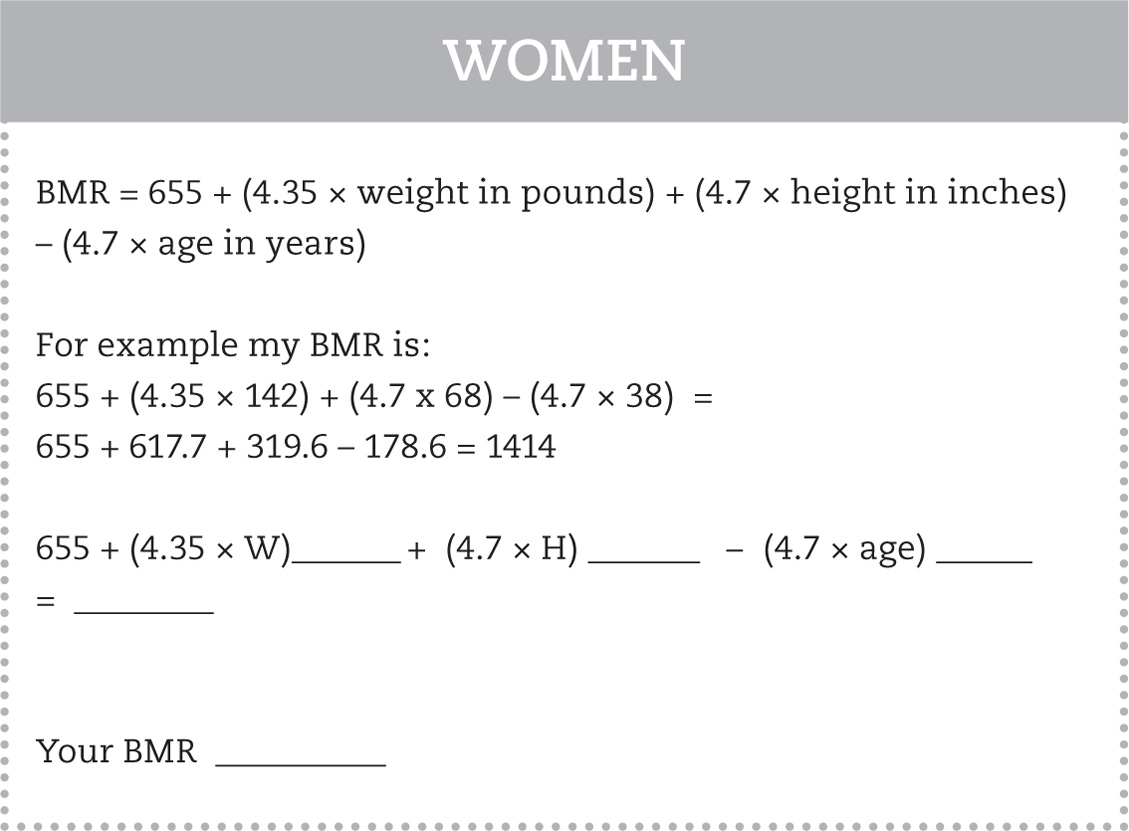
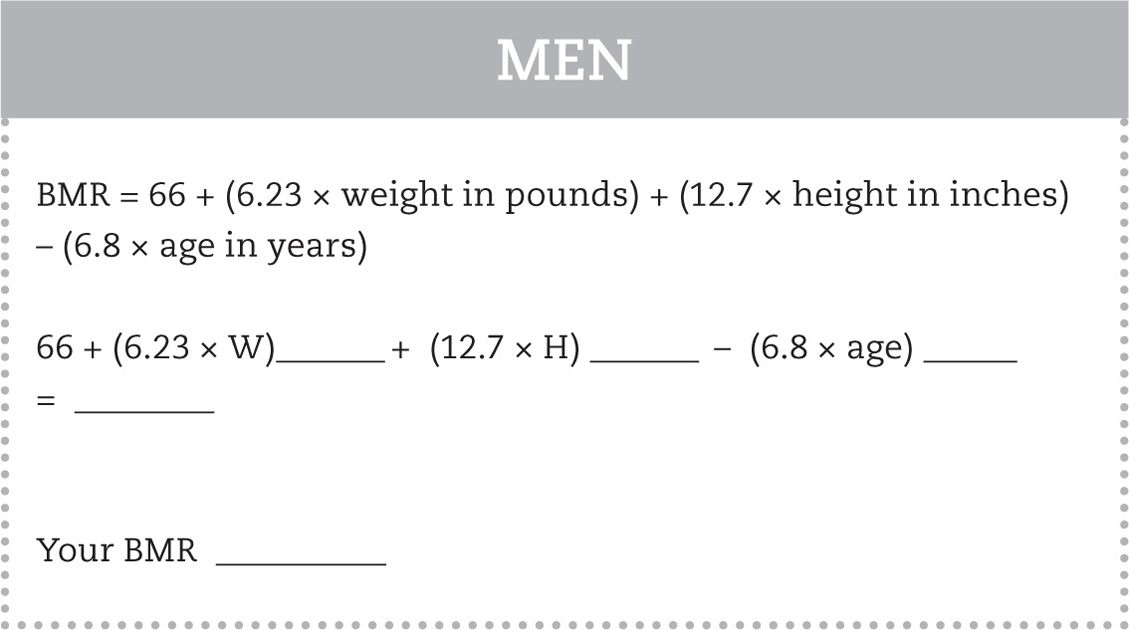
To calculate your actual calorie needs to maintain your current weight, you just need to work out where you are on the exercise scale.
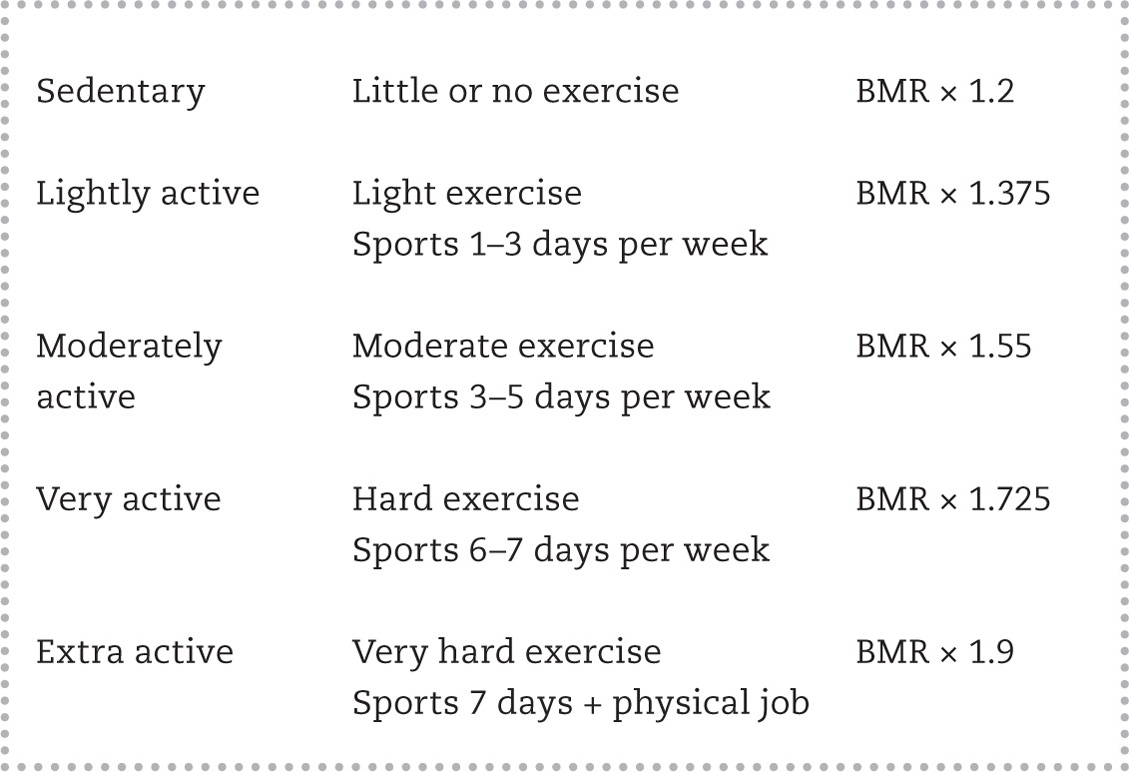
To work out the actual number of calories your body needs to maintain weight, multiply your BMR by the factor in the table above.
My maintenance calorie needs are:
I decide I am lightly active, so my multiplying factor is 1.375.
1414 × 1.375 = 1944 calories
I can also calculate how many calories I need to take in on my fasting days, as it is a quarter of this figure.
1944 ÷ 4 = 486 calories
So when I work out how many calories I am going to eat on a fast day, I need to make sure it is less than 486.

You should end up with the number of calories you need to eat on your fasting days. If you are like me, it will be slightly lower than 500 calories, but you might find you have a bonus of a few extra calories instead!
Don’t forget, if you lose a lot of weight, but find it slackens off after a while, you might need to re-calculate your calorie intake, as these formulas depend on your weight.
There is also one more thing that is worth considering: there are about 3,500 calories in 1lb of stored body fat. That means you need to reduce your calorie intake by 3,500 to lose 1lb in weight. That might sound like quite a lot, but if you think of it in terms of the restricted calorie days, a woman has a calorie deficit of (2,000–500) = 1,500 per day on a fast day, so will reduce her calorie intake by 3,000 over a standard 5:2 week. For a man this figure is increased to a 3,800 calorie reduction. This means that without doing anything else, a woman will lose just under 1lb a week on the 5:2 diet; a man, just over 1lb.
Taking into account the level of exercise and healthy eating on non-fast days, then we are looking at an even greater weight loss. This is simple maths and doesn’t take into consideration the effects that the 5:2 diet has on the body, which research is showing is more effective than standard diets.
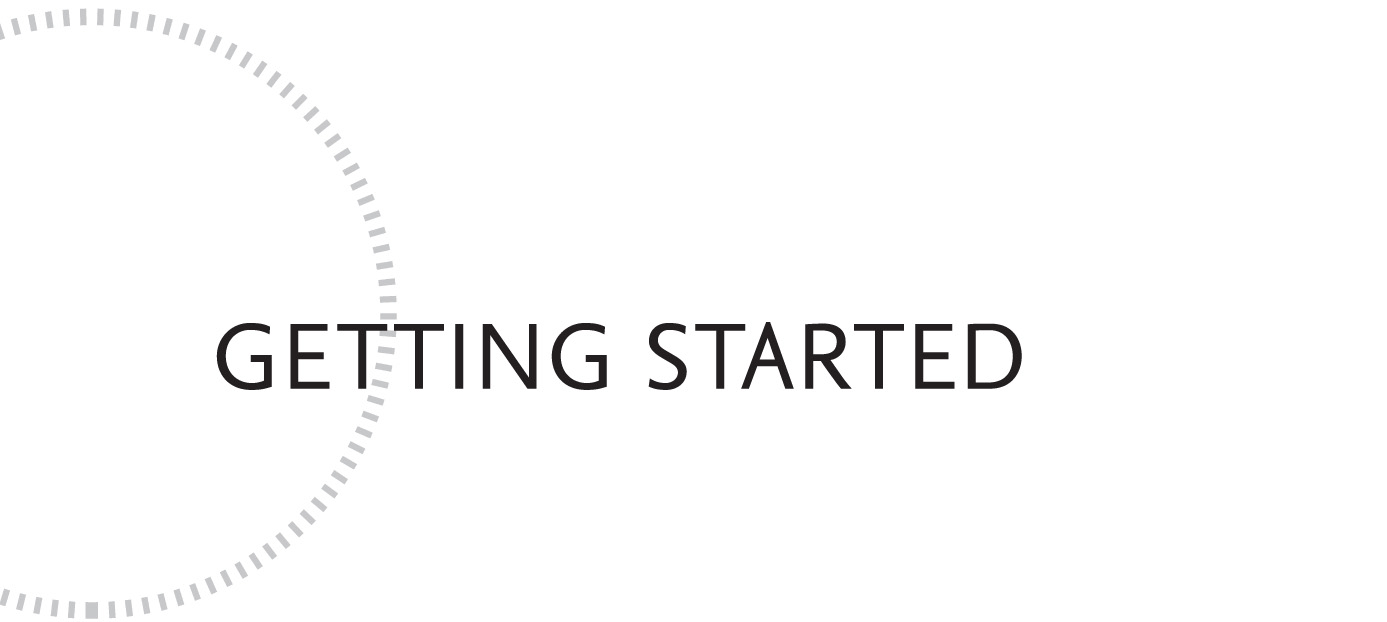
Now you know the basics it’s time to get started and think about your first fast day.
Are you fit and well and ready to lose some weight?
The first thing to think about is what days would be most suitable for a fast. Remember, you need two days a week with at least one rest day in between. You can have a set routine and pick the same days every week or pick and choose. The diet is extremely flexible and is designed to fit in around you and not the other way round.
What days do you normally fast?
‘Tuesdays and Thursdays. My husband is out so I don’t have to worry about catering for anyone else on those days.’
Peggy
Monday is a common day to start as most people want to enjoy their food at the weekend and are ready to start the new week with good resolutions.
‘I like to fast on a Monday, to get rid of that weekend bloat, and on a Thursday, in preparation for the weekend bloat!’
Jodie
Take a look at your schedule for the week and rule out any days where you have social engagements, especially involving food.
‘My fast days are variable, depending on what I am doing that week. It changes from week to week.’
Christina
Look at this as the greatest asset of the diet. Imagine going out for dinner with friends, not worrying about what you eat and even having a dessert and wine, and all the time losing weight.
Do the planning, do the fast days and then for five days a week, don’t diet. Especially when you are first starting out, your diet days should be the least social days on your calendar. They are also likely to be busy days or work days, as you want to be distracted from food and away from the kitchen as much as possible. The only restriction on your fast days is that you must have a rest day between fasts.
Your first fast day will probably be the hardest as your body needs time to adjust to the new regime. So make sure you pick your days wisely when you start out. For the first two weeks you need to give careful consideration to when you fast as there is a possibility that you will feel lightheaded, grumpy and perhaps get a headache as well as feel properly hungry. Don’t worry or be alarmed. There are plenty of tips here to deal with all these things. After the first two weeks of fast days, you will see it getting considerably easier. Focus on the fact that it’s only one day.
Setting targets
Before you start you need to take your starting weight. Don’t think about it too much – everyone’s starting weight is high, otherwise you wouldn’t be thinking about your diet. Think positively. Think how good you will feel when you start losing weight.
Starting weight:__________ st __________ lb
A few tips about weighing yourself
Don’t worry about only weighing yourself once a week. You should weigh yourself when you like, just try not to do it every day as your weight can go up as well as down. We only care about the downward trend.
Ladies, be aware that your bodily cycle will have an impact on your weight. You may put on weight the week before your period and may also find fasting harder during this time. Try and stick with it and make allowances for your cycle if you find you haven’t lost as much weight as you would like.
I would recommend weighing yourself the morning after your second fast day of the week. If you fast on Mondays and Wednesdays, then Thursday morning before breakfast or a drink and after you have been to the toilet is when you will be at your lightest. If you can, use this as your weekly weigh-in to see if you have lost weight and hit your target.
How much weight should you aim to lose?
This will depend entirely on your starting weight and fitness. If you have got more to lose, you will lose weight faster and can set a higher target. If you are quite close to your target weight and already reasonably fit, you won’t be quite as quick but you will still lose weight.
The target for your weight loss should be between 1 and 4lb per week. This is not a crash diet and you should only be aiming to lose weight in a safe and sensible way.
As a general guide, if you are just fasting but not exercising you should aim to lose 1lb per week. If you are fasting, exercising and staying healthy on your normal days then you could potentially see a weight loss of 2–3lb per week.
If you have more weight to lose then your target could be potentially higher than that.
Target weight loss per week: ___________ lb
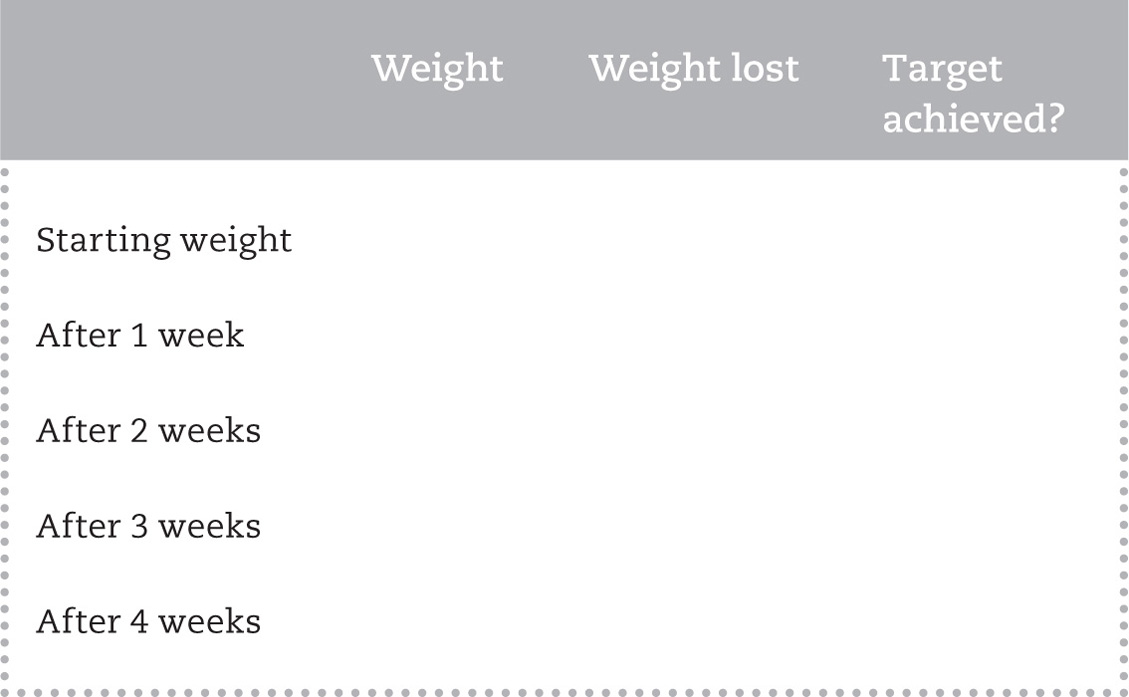
It is also worth calculating your BMI at the start and end of the four-week period. You should have dropped at least a couple of points and may even have crossed into a healthier bracket.
Starting BMI: _______________
(Look in the ‘Magic numbers’ chapter on here if you want help calculating your BMI.)
BMI at the end of the 4-week plan: _______________
Looking at your body tone and fitness
Try looking at yourself in the mirror before you start, as it will help you see which areas you would like to look better for the summer. If you want to see the improvements, you need to see what you look like before as well, so ladies, put on your bikini or swimsuit, and gentlemen get your board shorts out. It’s time to try them on and have a good look at yourself in a full-length mirror.
First of all, ignore the fact that you are probably a little pasty – everyone looks like that at the beginning of summer and we all know how to fix it. That is a different problem.
What you want to be looking at is where you think your problem areas are. Is it your tummy? Thighs? Cellulite? Or a little bit of everything?
The 5:2 Bikini Diet exercise programme is designed to burn as much body fat as possible while improving muscle tone, giving you a leaner, healthier body in just 30 days. Remember that the diet will help shift the excess pounds, specifically some of the fat. Where we need to help out with exercise is to bring some definition to the flab.
Exercising three times a week for four weeks, as well as following the 5:2 diet, will bring noticeable changes to your body shape. After four weeks put on your swimsuit again and see if you can spot the changes. Then slap on a bit of fake tan if necessary and get yourself to the beach!
Your first fast day
You need to do a bit of planning before you start on the first fast day. There are many different ways in which you can eat your 500/600 calories, but I would recommend that on your first day you have three small meals.
For women this means something similar to:
100 cals for breakfast, 150 cals for lunch, 250 cals for dinner
For men this could look like:
100 cals for breakfast, 200 cals for lunch, 300 cals for dinner
You should plan out exactly what you are going to eat. Take a look at the recipe section (see here) for some inspiration. Try not to eat much carbohydrate as this is very calorific. Stick to lean meats, vegetables and complex carbohydrates such as pulses or beans. Don’t consume too many calories in drinks. Drink black coffee or tea, diet colas, etc. An omelette (one large egg has 89 calories) makes a good, filling and simple meal. A salad is also a good option for lunch or dinner.
If you normally drink caffeinated drinks, don’t cut them out, as a sudden lack of caffeine could give you a headache and make the fasting day harder. If you like milk in your tea or coffee just remember to count the calories. A cup of tea or coffee with (50ml/scant ¼ cup) semi-skimmed (low-fat) milk has 25 calories, made with skimmed milk it has 19 calories. A short skinny latte from Starbucks has 67 calories and a tall skinny latte has 102 calories.
You may find the evening rather long and drawn out too. As you have hopefully had 250–300 calories for your dinner you actually won’t feel as hungry as you did during the day. But if you are at home with some snacks in the cupboard then you may well need some will power. Top tips to get you through your first fast day evening: find something good on the television, have a hot drink and go to bed early!
Remember:
• Feeling hungry is a natural state.
• Have a calorie-free drink to satiate your hunger.
• The first fast day is the hardest.
• You only have to do it once.
• Tomorrow you can eat like a king.
• You are actively losing weight right now.
• Feel proud and revel in a real sense of achievement.
Your first normal day
Congratulations on making it through your first fast day! If you want, you can weigh yourself before you eat or drink anything. You may well have dropped 1lb in your first day. Now, normally I would be suggesting that you eat healthily and don’t snack on the day after a fast, but I think the rules can go out of the window on the first day. So you can eat what you like. Even though you have most likely been looking forward to your breakfast for most of the day before, you may find you are not as hungry as you thought. Or you may find you are starving and can’t stop eating. Don’t worry about it. It’s just your body adjusting and you can allow yourself some treats.
I remember on my first normal day I didn’t feel as good as I was expecting. The big breakfast made me feel tired and lethargic and I found it hard to get motivated all day. I have heard similar tales from others when they were just starting out with the 5:2 diet. These feelings will change quite dramatically as you continue with the diet. Just as the fast days get easier, the normal days get more, well, ‘normal’ really.
FAST DAYS
I suggested that you should eat three small meals on your first fast day. As you continue with the diet, you will probably want to adjust this to suit your body’s needs and your lifestyle. It is normally wise to leave at least 50 per cent of your calorie intake for the day until your evening meal, although you can eat this meal as early as you like, any time after 5 p.m. But how you split your breakfast and lunchtime calories is more interesting. You could skip breakfast, skip lunch or have a small meal at each.
Here are a few questions that might help you decide how best to manage your meals on a fast day.
• Do you get up early?
• Do you work in an office?
• Are you exposed to unhealthy food during the day?
If you answered yes to some or all of the above questions then it might be worth considering missing breakfast and having a slightly more substantial lunch. Why? Because eating at lunchtime will make it easier to avoid snacks during the day. If you are rushing out first thing, you should find it easier to miss breakfast.
• Are you busy during the day with little time to think about food?
• Do you feel cranky if you skip breakfast?
• Do you have a morning ritual which involves breakfast and coffee?
If you answered yes to some of the above questions then you should try having a bigger (200–300 calorie) breakfast and then going through until your evening meal. Why? If you are busy at work you will not notice lunchtime.
If you are still unsure, stick to three small meals and perhaps adjust a little when you discover your hungriest times of day.
Count your calories
This is, I admit, the boring bit of a fasting day. You have to count calories and you need to do it accurately, without leaving anything out. Don’t allow yourself any snacks between meals (except low-calorie drinks), as a snack will just waste your calorie allowance.
Read the packet of anything you are planning to eat, as practically all packaging will list the calorie content, then use one of the recipes in this book, which has been accurately calorie counted for you. Or, make up your own recipes, counting the calories in each individual component, using the calorie reference at the back of this book (here).
You will find that you have a few favourite dishes that you come back to time and time again. It’s often omelettes or eggs in some form, or a salad. You will be able to work out the calories once and know for next time.
Feeling hungry – it’s a good thing
I’m going to be totally honest here: you will feel hungry on your fast days. It may be a new kind of hunger that you have never experienced before, but it’s not a bad thing. It won’t make you ill and your body adjusts to it very quickly. This is because hunger is a natural state for our bodies, which haven’t fundamentally changed since the Stone Age. Hunger makes us energetic and efficient and we use our coping mechanisms to find solutions to the hunger. In the old days this would have meant hunting for food. When we feel hungry by choice, this means finding distraction mechanisms.
‘I have a drink to deal with hunger pangs or nibble on a carrot stick.’
Sarah
You will notice two positive things on your fasting days that you won’t believe until you try it. First of all, you will have more energy, not less. It’s unbelievable I know, but the majority of people on the 5:2 diet feel great on their fast days. I tend to feel lively, very chatty and have a natural buzz – the same kind of buzz that I get when I exercise. This feeling may not appear on the first fast day, but give it a week or two and start enjoying the feeling.
‘I’ve had more energy, so the house is cleaner. The windows have never been so clean!’
Deek43
The second thing that seems a bit crazy before you start is that hunger comes in waves and normally passes in a few minutes if you think about something else. I tend to feel a real wave of hunger mid-afternoon, a time when in the past I would tend to snack unhealthily, but I now head out for some fresh air and don’t think about food, and the feeling goes away. I might not feel hungry for another couple of hours and then it’s nearly dinnertime and I’m on the home straight.
Special mention to mums at teatime
Are you a mother of young children? Do you struggle on a fast day at teatime? Because I do. With a meagre breakfast and/or lunch, by teatime I am hungry, and then I have to prepare food such as pasta or chips (French fries), which I can’t eat. It’s just the temptation to pick up the odd chip that I find really hard to resist, because I could do it without even thinking about it.
So if you find yourself in a similar situation, you are not alone. I try and eat with the children or soon after. This helps, as I know my food is on its way. If there’s ever a time to employ the best of your willpower, it is now. Remember there are many mothers out there sharing your pain.
My backup plan after a hard day: fish fingers and beans, then we can all eat together. Two fish fingers and a quarter of a 415g can reduced sugar and salt beans has 220 calories and is very filling.
Fast day evenings
Do you eat your evening meal and then find the evenings rather long and boring? Do you find yourself constantly wishing you could eat some chocolate or cake? Don’t worry, this happens to the best of us. You are probably not that hungry, it’s just a bad habit, which is worse because you are relaxing.
Here are some of the things I like to do to keep myself busy and keep my mind off food until bedtime.
Take up a hobby – anything will do, something you do at home or go out to, as long as there’s no food or drink involved.
Watch a movie – go to the cinema or put a movie on the TV. A movie is longer than a TV programme and if you are enjoying it, you won’t be thinking about food.
Go for a swim – exercise is generally not a great idea on a fast day, but some gentle swimming is very distracting and no one is eating at the poolside.
Have a hot drink – fruit tea has no calories. I like peppermint myself. Another option if you have allowed yourself the calories is a low-cal hot chocolate drink. Normally around 40 cals, these will stop that chocolate craving.
‘I make myself a black tea or glass of water, ring a friend and try to take my mind off it. It’s only really bad just before I go to bed as I’m relaxing and nothing distracts me, but it doesn’t last and when I wake up the next day, I’m no more hungry than normal.’





